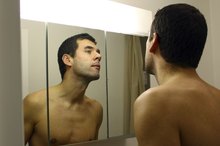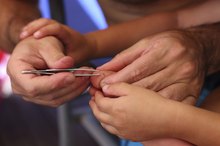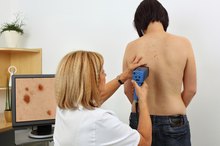According to Princeton University, moles are spots on the skin that have more pigment producing cells than other areas on the body 1. Moles are usually rounded, symmetrical and benign. However, sometimes they can develop into skin cancer and should be removed. There are some side effects to be aware of when having moles removed.
Pain
Pain is one of the most common side effects of mole removal. According to Plastic Surgery, the amount of pain is dependent on which method of removal is used 2. For example, burning the mole off can sometimes be more painful than simply having the mole shaved off. In addition, small moles are not as apt to be painful after being removed but larger moles can cause mild pain. Burning or surgically removing the mole can cause an irritation of the skin that can be somewhat painful. Usually your physician will recommend that you take a mild pain reliever like ibuprofen to treat this pain. The pain usually subsides within 24 to 48 hours but if it persists, seek the advice of your physician.
- Pain is one of the most common side effects of mole removal.
- In addition, small moles are not as apt to be painful after being removed but larger moles can cause mild pain.
Scars
How to Freeze Skin Moles at Home
Learn More
Scaring of the site after a mole has been removed is common. Generally, the larger the mole, the larger the scar will be. However, according to the Mayo Clinic, a larger wound such as those from excisional surgery may require sutures. Sutures in the wound can lessen the effects of the scarring left on your skin. According to Cosmetic Surgery some scars can fade away but others may need to be treated by using skin resurfacing 2. If the mole is in a prominent place, such as on your face, you may want to discuss this issue with your physician before having the procedure performed.
- Scaring of the site after a mole has been removed is common.
- If the mole is in a prominent place, such as on your face, you may want to discuss this issue with your physician before having the procedure performed.
Infection
According to Cosmetic Surgery, infection is a possible risk when having a mole removed 2. Keeping your skin clean and washing the wound site a couple of times a day is usually recommended by physicians. Signs of an infection include reddening of the site, pain, a hot feeling to the skin and pus coming from the wound. If you see any of these signs you should seek medical advice immediately. Sometimes, if infections are not treated, germs can get into your bloodstream and cause a blood infection called sepsis, which can be life threatening.
- According to Cosmetic Surgery, infection is a possible risk when having a mole removed 2.
- Sometimes, if infections are not treated, germs can get into your bloodstream and cause a blood infection called sepsis, which can be life threatening.
Related Articles
References
- Princeton University: Skin Care
- Cosmetic Surgery: Mole Removal
- Bhatt M, Nabatian A, Kriegel D, Khorasani H. Does an increased number of moles correlate to a higher risk of melanoma?. Melanoma Manag. 2016;3(2):85-87. doi:10.2217/mmt-2016-0001
- Sardana K, Chakravarty P, Goel K. Optimal management of common acquired melanocytic nevi (moles): current perspectives. Clin Cosmet Investig Dermatol. 2014;7:89-103. doi:10.2147/CCID.S57782
- Fink E. [Health behavior from the gender perspective--The concept of "doing genders" and the perspective of intersectionality as an explanation]. Gesundheitswesen. 2015;77(11):880. doi:10.1055/s-2006-949120
- Wu S, Han J, Li WQ, Li T, Qureshi AA. Basal-cell carcinoma incidence and associated risk factors in U.S. women and men. Am J Epidemiol. 2013;178(6):890-7. doi:10.1093/aje/kwt073
- Barnhill, RL, and H Rabinovitz. “Benign Melanocytic Neoplasms.” Dermatology, 2nd Ed. Eds. Jean Bolognia, et. al. Mosby, 2008. 1723-6.
Writer Bio
Kristie Jernigan is a health writer with over 17 years of experience as a medical social worker. She has worked mainly with the elderly population and with children. She holds a Bachelor of Science in psychology and early childhood from East Tennessee State University and a Master of Science in health care administration and gerontology from the University of Phoenix.








